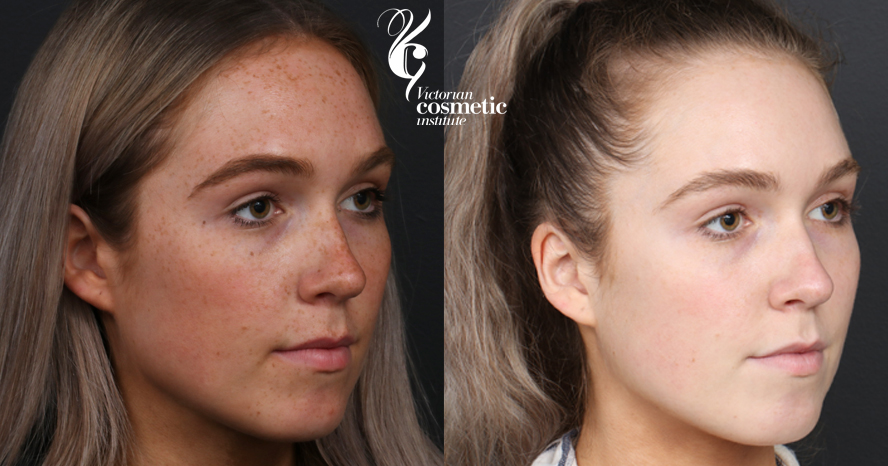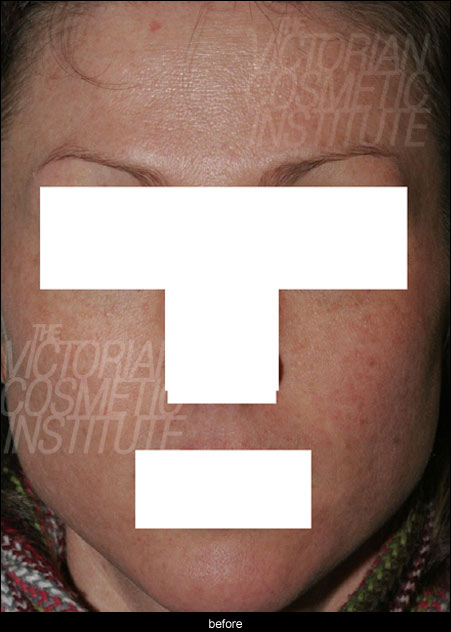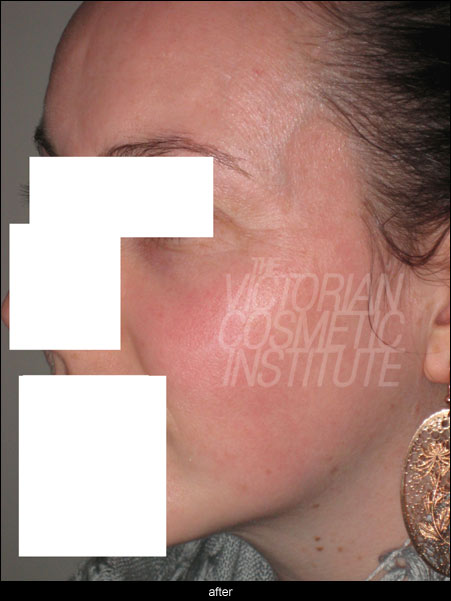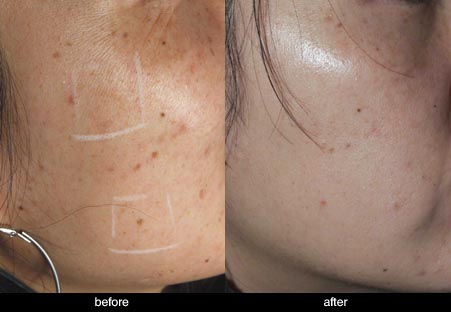Freckle Removal Treatment
The Australian sun can lead to the development of freckles on the skin. While these freckles are generally harmless, some individuals prefer a more even skin tone. To address this, a range of freckle removal treatments have been developed to help even out skin tone, promoting a more uniform complexion.
What are freckles?
Freckles are flat spots of dark pigment on the skin due to uneven distribution of melanin (skin pigment) in those areas. They are usually about the size of a matchstick head and are reasonably uniform in colour.
Sun-exposed areas of the skin are where freckles tend to develop the most, including the face, neck, arms, and shoulders. They also tend to darken further or multiply after excessive sun exposure.
Freckles are usually harmless and are not a sign of skin cancer or sun damage.
What are freckles caused by?
A combination of genetics and sunlight determines freckles’ appearance. People with fair skin are usually more prone to freckles because they have fewer melanocytes in their skin (skin cells that produce melanin). Thus, when their skin is exposed to the sun it creates clusters of pigmentation rather than an even tan. Melanocytes are typically unevenly distributed in those with lighter skin, hence why they tend to develop more often for those individuals.
People with red hair are more likely to have freckles because they already have the MRCI gene (this is the gene that determines red hair and also controls whether some people have freckles). However, anyone can get freckles, even those with darker skin. Additionally, the freckles themselves may vary in colour from light to dark brown and even tan or red.
Freckle removal treatments
There are several treatments available for freckle removal, including lasers, skincare and chemical peels. Each has their own individual treatment plans, timelines, and skin types that they work on. Thus, it is essential to book an initial consultation with your practitioner to determine which method would be most suited for your skin’s needs.
Laser treatments are one particular example of efficient freckle removal techniques. Victorian Cosmetic Institute has three main laser technology methods to lighten freckles and remove other pigmentations. They may also be used with other pigmentation removal treatments to revitalise the skin and remove freckles, age spots or sun spots when recommended by your practitioner.
Fraxel laser
Fraxel laser (1927nm wavelength) is an effective treatment for freckle removal due to its method of being attracted to water in the skin, rather than the melanin. This fractional laser can thus carefully target the surface layers of the skin where freckles lay, exfoliating it and leaving it clear of uneven pigmentation.
The Fraxel laser operates by firing very fine columns of laser energy into the skin, sparing the skin in between the columns. This means that the entire skin area is not treated at once, allowing for faster healing and recovery times.
Such an approach with laser energy is one of the preferred methods of full-face freckle removal on fair skin types since there are often more freckles to target.
Gemini laser
The Gemini laser can be used on Asian, olive, or darker skin types for treating localised areas of freckles because it uses a wavelength that targets pigmentation while minimising the risk of post-inflammatory hyperpigmentation (PIH), which can be a concern with darker skin tones.
Additionally, the Gemini laser uses longer pulses to provide less risk of post-inflammatory hyperpigmentation than q-switched lasers with the same wavelength on Asian skins. This hyperpigmentation is the eruption of pigmentation post-laser treatment or trauma to the skin. The risk of this can be reduced, but not eliminated, by using the Gemini laser.
Whilst the Gemini laser can be used for smaller areas of freckles, it is generally not used for a full face treatment. Treatments such as the Cosmelan Peel Program are more suited to full face treatments on darker, Asian or olive skin types.
Ruby laser
Another common laser used for the treatment of freckles is the Ruby laser. The Ruby laser has a wavelength of 694nm, which is highly attracted to melanin. Freckles, which are higher in melanin than normal skin, thus tend to attract the energy from this laser wavelength. When the laser energy is absorbed by the freckles, it leads to the destruction of the melanin in the freckle and its eventual removal.
Furthermore, the q-switched Ruby laser uses extremely short pulses of laser energy, usually only lasting a few nanoseconds. The production of high energy levels in this short period has a photo-acoustic effect on the melanin in the freckles, meaning it breaks down the pigment particles. This is what makes the Ruby laser a popular method to treat freckles and is most suited to lighter skin types.
IPL skin rejuvenation
Intense Pulsed Light (IPL) Skin Rejuvenation is a non-invasive treatment that also encourages collagen and elastin growth. By directing intense pulsed light into the targeted area, the light and heat stimulate the natural healing process. In turn, this rejuvenation can reduce the appearance of pigmentation like freckles, caused by sun exposure or genetics.
Skin needling
Otherwise known as collagen induction therapy or microneedling, skin needling encourages the natural healing process much like IPL treatments. With the application of fine needles to freckled areas, the skin increases its production of collagen and elastin, leading to smoother skin and even pigmentation.
At the Victorian Cosmetic Institute, we use skin needling to infuse a customised blend of ingredients designed to lighten pigmentation and prevent further pigmentation forming. This tailored approach aids in the freckle removal process.
Chemical peels
Chemical peels provide a non-invasive option for treating freckles. Once applied, the peels resurface the skin by removing the topmost layer, stimulating collagen production. This production tends to lead to the improvement of sun-damaged skin or pigmentation issues, including freckles.
There are several chemical peels on offer to treat freckles, ranging from superficial to deep in its targeting of skin layers. Each peel method suits particular skin types and concerns, so it is best to ask your skin therapist ahead of time to determine which method suits your needs.
The Cosmelan peel program has been specifically designed to treat pigmentation concerns, such as freckles, for all skin types. It is a treatment method that must be performed under a professional’s guidance, using pre-treatment preparation products and post-treatment care at home alongside multiple in-clinic treatment appointments. There is a minimum of 4 treatment appointments required as a part of this program for optimal results.
As a general rule, the deeper a peel is the more recovery time is required as there also tend to be more side effects. Take care to plan your treatment session and its repeat if necessary ahead of time.
Skincare
Clinical treatments may provide noticeable freckle removal results on their own, but the addition of skincare treatments may enhance the results. Additionally, pigmentation skincare may help to reduce the appearance of freckles with continuous use. However, it should be important to note that they do not succeed in the complete removal of freckles. Rather, they are used to prepare your skin for in-clinic treatments, and also after your in-clinic treatments to help in evening out your complexion.
Other skincare products that may aid in the reduction of freckles’ appearances include:
- Vitamin A skincare products such as retinoid creams: The photoprotection offered by retinoid products prevents the damaging effects of UV B radiation. This means the products may help prevent new freckles from forming as the sun is the most common cause of their development.
- Vitamin C skincare and serums: When applied to the skin, vitamin C may suppress melanin cells and protect the skin from UV radiation. This prevents the further development of freckles while lightening existing ones.
To help prevent the development of freckles, it is important to avoid excessive sun exposure. This can be aided by the morning application of sunscreen and regular reapplications throughout the day.
How to prepare for freckle removal treatment
In the lead-up to your freckle removal treatment, it is common for your practitioner to provide a guide for preparation. Your practitioner will generally advise you to:
- Stop the use of harsh topical ingredients like steroidal or retinoids if you’re undergoing a laser treatment
- Limit sun exposure
- Avoid fake tanning, waxing, threading, or tweezing in targeted areas
- Cleanse your skin before the appointment to ensure it is as clean and dry as possible
During your initial consultation, you will be provided with specific instructions about preparing for the appointment. If you are taking any medications or you have other procedures booked, you should inform your practitioner.
What is involved in freckle removal treatment?
The exact process for freckle removals depends entirely on your treatment plan.
Generally, however, any laser freckle removal treatments include the application of numbing cream for pain minimisation. This helps to reduce the discomfort from the treatment, which usually comes in the form of a snapping sensation from the laser and some heat.
Other treatments like IPL and chemical peels will not typically require numbing cream, but you may be cleansed ahead of time or a masking agent applied to protect the eyes. You may also be provided with a fan to cool the skin and keep you comfortable during treatment.
Once treatment has concluded, it is typical for the freckles to appear darker than normal. The surrounding skin of the targeted area may also appear red and swollen. Ice packs or an air cooler are usually applied to the skin post-treatment to help reduce the amount of heat, swelling and redness.
Treatments are usually spaced at least one month apart, and the number of sessions required will vary depending on which treatment is provided.
Freckles may return with sun exposure, so it is extremely important to wear sunscreen daily, both before and after treatment.
Who is a suitable candidate for freckle removal treatment?
Anyone with visible freckles who is over the age of 18 and in generally good health would be a candidate for freckle removal treatment.
A consultation will help to determine what particular treatment is suited for your skin type and concerns.
Are there any risks or side effects to freckle removal?
There may be some side effects once you have finished treatment. The exact effects will depend entirely on your chosen treatment and skin type.
Potential side effects with freckle removal treatments include:
- Darker freckles immediately after treatment
- Lingering heat
- Redness
- Swelling
- Itchiness
- Temporary hyperpigmentation
- Scarring
It is common for the freckled area to form a scab in the days following certain procedures like lasers, which will then fall off. Proper aftercare may reduce side effects and optimise treatment effectiveness.
How to care for your skin after freckle removal treatment
There are some common yet effective methods of caring for your skin after freckle removal treatment, particularly if you are experiencing redness or swelling.
If you are feeling discomfort, it is recommended to:
- Use ice packs on inflamed areas
- Take over-the-counter pain medication as needed
- Avoid sun exposure
- Refrain from using harsh topical products containing AHA, BHA or Vitamin A
- Use sunscreen every day, regardless of how much time you spend in the sun
Your practitioner may also recommend a post-treatment balm to soothe the area during your recovery period.
FAQ
What is the cost of laser freckle removal?
Treatment pricing varies depending on which laser, peel or skin treatment you have performed for freckle removal. Pricing will be provided during a consultation with one of our practitioners, along with a detailed treatment plan. Consultation pricing can be found on our pricing page.
Can freckles be permanently removed?
Freckles are a result of melanin deposits near the surface of this skin. Whilst freckle removal treatment may reduce or even remove freckles, the results cannot be considered permanent.
This is because freckle removal treatment does not prevent you from developing more freckles in the future due to sun exposure. To avoid developing more freckles, you will need to use SPF50+ sunscreen and wear adequate sun protection such as a hat and sunglasses. Additional serums designed to treat pigmentation may also assist in further pigmentation from forming.
Can freckles come back after being treated?
New freckles may form after unprotected sun exposure. To avoid developing more freckles after treatment, you should apply generous quantities of sunscreen, reapply throughout the day and avoid excessive sun exposure.
Is laser freckle treatment painful?
Laser freckle treatment should not be painful. Some forms of laser treatment will require the application of a topical numbing cream prior to the laser treatment commencing. The skin may feel warm during and after the procedure. Any discomfort following the procedure may be calmed using ice packs and over-the-counter pain medication.
How many laser treatments will I need to remove my freckles?
The number of treatments you’ll need may vary depending on the extent of pigmentation, the type of treatment you are prescribed, and the amount of freckles you have. During your initial consultation, your practitioner will conduct a thorough skin analysis to identify the depth of discolouration.
Why choose Victorian Cosmetic Institute as your provider of freckle removal treatment?
With years of training and experience, Victorian Cosmetic Institute performs various freckle removal treatments, providing options to treat multiple skin types at our clinics located around Melbourne.
The first step is to contact us for your initial freckle removal consultation, where we will assess your freckles and provide a tailored treatment plan. You can book your consultation by clicking the book online button or you can phone our Customer Care team directly on 1300 863 824 who will assist you with finding a suitable consultation time.
Last updated August 2024






